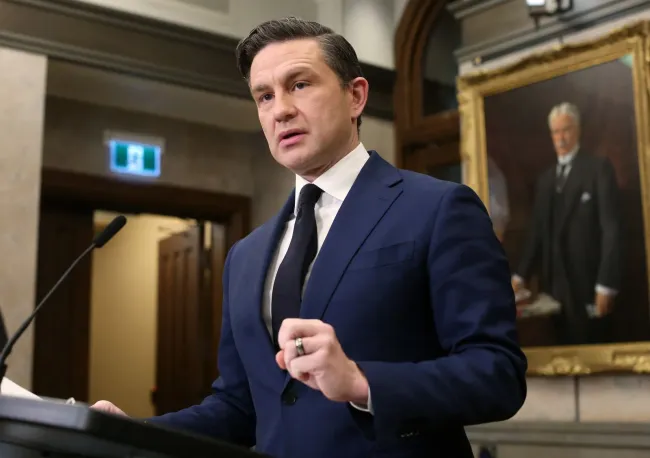Pierre Poilievre: In-Depth Look at His Political Journey, Key Policies, and Latest Moves in 2025
Pierre Poilievre, the rising Conservative star, has steadily built a political career defined by his staunch conservative principles and sharp partisan tactics. From his early activism to his latest bold moves, including challenging Mark Carney and taking on Donald Trump’s tariff threats, Poilievre’s vision for Canada’s future is taking shape. As the Liberal Party searches for a successor to Justin Trudeau, Poilievre is positioning himself as the disruptive force ready to lead the country in a new direction. Here’s an in-depth look at his background, policies, and the political moves that could soon place him at the helm of Canada.
1. Pierre Poilievre’s Early Life and Political Beginnings
Pierre Poilievre’s path to politics was shaped by conservative values and grassroots activism from an early age. Born in Calgary in 1979, he was adopted by schoolteachers Marlene and Don Poilievre, who emphasized personal responsibility and voluntary generosity over government intervention.
Education: Poilievre studied international relations at the University of Calgary, where he led the campus Conservative club. He gained early recognition after winning a $10,000 essay contest with his piece "Building Canada through Freedom," which championed low taxes and free-market principles—ideals that continue to define his political stance.
Early Career: Before becoming an MP, Poilievre worked as a political staffer for Canadian Alliance leader Stockwell Day and Jason Kenney. As a teenager, he actively recruited members for the Reform Party. He also briefly worked in corporate collections at Telus, though politics remained his primary focus.
Political Foundation: In his early 20s, he co-founded a political consulting firm and interned with Conservative politicians, honing his skills as a partisan strategist. His sharp attacks on opponents later earned him the nickname “Harper’s attack dog.”
2. Poilievre’s Open Letter to Mark Carney
With the Liberal Party searching for a successor to Justin Trudeau, Poilievre seized the moment to take aim at front-runner Mark Carney. In a January 2025 open letter, he accused the Liberals of clinging to “failed Trudeau-era policies” and called on Carney to commit to excluding former Trudeau ministers from his cabinet if elected.
Context: Poilievre portrayed Carney as a political insider tied to Trudeau’s economic policies, particularly the carbon tax and energy regulations, which he argues have weakened Canada’s position against U.S. tariffs.
Strategic Play: The letter reinforced Poilievre’s “Justinflation” narrative, positioning him as the candidate who would break from Trudeau’s legacy while painting Carney as a continuation of the same policies.
3. Poilievre’s Speech on Trump’s Tariff Threats
On January 17, 2025, Poilievre delivered a fiery speech in British Columbia, addressing Donald Trump’s proposal for a 25% tariff on Canadian goods. He vowed to stop what he called the “free ride” the U.S. has enjoyed under Liberal leadership.
Key Points:
- Energy Independence: Poilievre blamed Trudeau and Chrystia Freeland for blocking key pipeline projects, such as Energy East, which he argued would have diversified Canada’s export markets and reduced dependence on the U.S.
- Economic Vision: He pledged tax cuts, deregulation, and policies to attract investment and bring jobs back to Canada.
- Partisan Jabs: He mocked Carney as “Carbon Tax Carney,” claiming his policies have made Canada less competitive.
4. Poilievre’s Views on Religion
Although raised Roman Catholic, Poilievre rarely discusses his faith in politics. His parents’ divorce during his teenage years and his emphasis on individualism and limited government suggest his worldview is shaped more by ideology than religious beliefs.
5. Poilievre’s Approach to Trade and Tariffs
In response to Trump’s tariff threats, Poilievre has combined economic nationalism with free-market policies.
- Criticism of Liberal Policies: He argues that Trudeau’s carbon tax and pipeline restrictions have left Canada overly reliant on the U.S., giving Washington an advantage in trade negotiations.
- Proposed Solutions: He advocates for expanding LNG exports and building pipelines to access global markets, reducing dependence on U.S. buyers. Additionally, he pledges corporate tax cuts and regulatory reforms to attract investment.
- Framing the Debate: Poilievre portrays Carney and Freeland as responsible for “job-killing” policies while positioning himself as the defender of Canadian sovereignty and economic strength.
Conclusion
From his early days as a conservative activist to his role as a leading contender for prime minister, Pierre Poilievre has built his career on ideological consistency and sharp political instincts. His recent focus on trade and energy independence underscores his broader vision of economic self-sufficiency. Meanwhile, his attacks on Carney signal a high-stakes battle to shape Canada’s post-Trudeau future.
Whether voters see him as a bold reformer or a career politician disconnected from everyday concerns, Poilievre’s ability to tap into public frustration could soon propel him to the country’s highest office.
